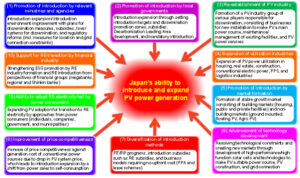Fiscal Year (FY) 2023 came to an end and FY 2024 has begun (FY: April to March). In FY 2023, the national government enacted the GX (Green Transformation) Promotion Act and the GX Decarbonization Power Supply Act, developed the Basic Policy for the Realization of GX into the GX Promotion Strategy and formulated the GX Investment Strategy as well. Thus, the government developed legal systems and secured financial resources to strongly promote the realization of GX as a national strategy.
The promotion of renewable energy is positioned as one of the major pillars in a series of these strategies for the GX. The relevant ministries and agencies are promoting the preparation and expansion of the introduction of renewable energy through measures under their jurisdiction, which will be continued and strengthened in FY 2024. Furthermore, FY 2024 will be an important phase in which the policies for the future of renewable energy will be reviewed. The Ministry of Economy, Trade and Industry (METI) will start reviewing the current Sixth Strategic Energy Plan and move toward the formulation of the Seventh Strategic Energy Plan. This time, the review would extend the target year from 2030 to 2035, as the submission of the Nationally Determined Contributions (NDCs) for 2035 to the United Nations is scheduled in 2025. Therefore, the target installed capacity of renewable energy is expected to be set for 2035 in addition to the one for 2030.
The previous review was conducted based on the premise of the transition of the dissemination environment for PV power generation from the former FIT program to the current FIT/FIP programs and the implementation of the revised Act on Promotion of Global Warming Countermeasures, which aims for carbon neutrality by 2050. Furthermore, with the addition of the greenhouse gas (GHG) emission reduction target of 46% by 2030, the previous review was made focusing on decarbonization, with the participation of the relevant ministries and agencies. Against the background of the global economy becoming more fragmented, the global energy situation and the agreement at COP28 to accelerate the breaking away from fossil fuels, the review of the Strategic Energy Plan this time will focus not only on decarbonization but also on ensuring energy security.
The framework to promote the expanding introduction of PV power generation has been drastically changing to a structure that was unthinkable under the former FIT program. The change is brought about by the ambitious target installed capacity set in the Sixth Strategic Energy Plan, as well as the implementation of the revised Act on Promotion of Global Warming Countermeasures and the cabinet decision on the basic policy to realize the GX. As shown in Figure 1, activities such as 1) promotion of introduction by relevant ministries and agencies; 2) promotion of introduction by local governments; 3) restructuring of the groups of PV industry; 4) expansion of industries utilizing renewable energy electricity; 5) formation of markets related to buildings and non-buildings; 6) advancement of technology development; 7) diversification of introduction methods such as a PPA model; 8) improvement of price competitiveness against conventional electricity; 9) expanding adoption of PV systems led by electricity consumers and 10) support for the conversion to renewable energy by the financial industry, have created a whirlpool of expanding introduction of PV power generation and are renewing the ability for the introduction and expansion of PV power generation in Japan, which had dominantly been driven by the FIT program. This ability for introduction and expansion is just beginning to take shape, and the enhancement of each element hereafter will greatly affect the ability for introduction and expansion hereafter. Although the ability of each element may be limited on its own, when these elements are bundled together, they will develop into a powerful ability for the introduction and expansion. Therefore, it is essential to enhance this ability for introduction and expansion.
For the formulation of the Seventh Strategic Energy Plan, it was clearly stated that the introduction of PV power generation as a core main power source is to be accelerated to promote decarbonization, while striving for ensuring harmony with local communities. Based on the assumption that grid and location constraints will be improved, an upward revision of the 2030 target PV installed capacity and the setting of a bold 2035 target installed capacity are anticipated. Hereafter, the sustainable development of PV business should be promoted by enhancing our ability to introduce and expand PV power generation thoroughly, aiming to establish the annual market size of 10 GW by 2030 focusing on the building market, and that of 15 GW by 2035, expanding into the non-building market, including the utilization of farmland, as shown in Table 1.

Figure 1 Strengthening of Japan’s required capabilities for introduction and expansion of PV power generation
©RTS Corporation
Table 1 Expectations for market creation toward 2030 and 2035 by setting new introduction targets
(GW/year)

©RTS Corporation
